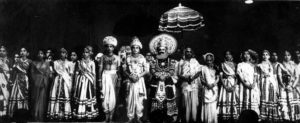In first of the four-part exclusive series, Shriram Bharatiya Kala Kendra director SHOBHA DEEPAK SINGH chronicles the changes in the presentation of the epic over the last six decades
The Delhi of 1957 was a far cry from the Capital city as we know it today. Kasturba Gandhi Marg, which runs parallel to the well-known Janpath in central Delhi, used to be called Curzon Road. It was in the basement of one of the buildings here that the first production of this Ramlila was held, 60 years ago. That building, to be precise, is where the headquarters of The Hindustan Times now stands. And that first Ramlila was produced with a sum of money sanctioned by Jawaharlal Nehru himself. I was 13 then. My mother had approached Pt Nehru for this production. And to think that I started off by playing a monkey!

Audiences who have had the opportunity to watch this rendition of Shri Rama at SBKK, first scripted by eminent Hindi writer Ramdhari Singh Dinkar based on Ramcharitmanas. It, thereafter, travelled to different parts of India and abroad. There surely is something compelling about this epic story of devotion, love, greed, righteousness, doom and disillusionment.
I believe Ramlila costumes are a relevant reminder of why Indians are so innately comfortable with mixing colours and fabrics, without any design or fashion training. It’s a part of our culture to wear blue with pink, or yellow with green or bring out silks for festivities and keep cottons as workday wear.
Long before designers began telling us that Banarasi is the new black of fashion or why wearing cotton as formal wear is about fashion elitism, we had a culturally sound sense about fabrics, colours, textures, their appropriateness and timeliness – in a simplistic way.
It was during my tenure in theatre direction course with renowned theatre-person Ebrahim Alkazi in the early 90s that my life somersaulted. I thought that even mythology needs to evolve with time. Thus, I decided to pull the productions out of the groove of blind faith and keep up with what people need today.
From the conventional Ramlila, the story of my approach to Rama metamorphosed into a tale where literal incidents such as Ahilya turning into a stone and the illusion of the golden deer turned into metaphorical ones. On the other hand, real props such as flowers and metal jewellery have been replaced by artificial ones which have survived till today.
Every production is a challenge and I think there are gigantic tasks in front of me. But if I concentrate hard enough, I can achieve anything.
I have dedicated my heart and soul into expanding the dimensions of the interpretation of Indian mythology through dance-dramas the most iconic being, Rama. These have been wonderful 49 years. From cataloguing in the early 70s, I was promoted to costume designing. Over the years, I have had multiple personalities: Costume designer, producer, photographer, script writer and now the director of Shriram Bharatiya Kala Kendra for 20 years.
I believe it is futile to do any mythology unless we can make it relevant to today’s generation. The narrations which run during the plays are self-explanatory. But dance brings out the essence of the story and the narration. I have brought in a lot of modern aesthetic elements on stage for dance dramas-like stronger lights and smarter sets.
In 1957, there used to be three stages here. The backstage was designed in such a way that the actors would have to run across the stage from one corner to the other to enter and exit and also the curtains were extremely bulky. One year, I tried to conceptualise and design the set for Ramayana and focus on designing palaces and forests. We came up with the idea of revolving panels. So, on one side of the panel, was a palace and on the other side, a forest set. My husband helped us transform the stage.
Back then, the audiences used to generally consist of elderly people. At that time we had only one main show, Ramayana, and they loved watching it. As time went by, the production values got enhanced. Soon older people and their children also started watching the show.
Now, a majority of the crowd consists of the younger generation. This has been possible because we’ve tried to take the theatre to the absolute taste of young audience, the Snapchat generation. How then does this Ramlila manage to stay relevant with the fast, digital times of today? For the last few years, we’ve included a simple PowerPoint presentation (PPT) that runs on a screen simultaneous to the dance drama on stage.
The Kendra’s Ramlila enters its 62nd year in 2018. A ticketed event, as opposed to most of the other Ramlilas that are open for the masses, it provides a proscenium exemplary sets, lighting, sound, resplendent costumes and installation choreography. But what attracts people to it and keeps them glued through the 150 minutes of this dance drama are the emotions and the nostalgia of revisiting a much loved, and for many a much revered, mythology.
Photos: SBKK Archives
Tomorrow: The wheel of karma and the call of dharma